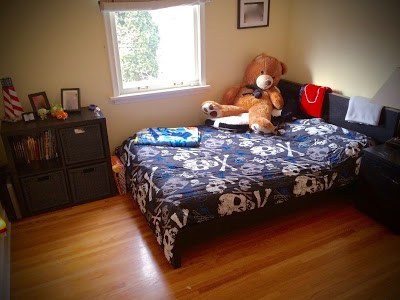Designing your child’s bedroom can be a tall order – after all, kids are constantly changing and growing out of things, and their room needs to grow with them. So where do you start? One solution may be to focus on what doesn’t work, rather than what does. Beyond that, kids’ room design is something of a free for all. After all, kids don’t thrive because they have the perfect bedroom, but because there are people in their life who want them to be happy and safe.
Mistake #1: Not Puting Safety First
Bedroom safety is a top priority with children of every age, with nearly 3.5 million children injured at home every year, so when designing your child’s bedroom, this is a good place to start. Cover outlets with safety caps, make sure your child’s crib or bed is placed away from the windows, and that furniture, especially dressers and shelves, are secured to the walls. Children are notorious for climbing on their furniture and tip over injuries are especially common among young children and can cause serious injuries or even death, depending on the piece of furniture and the size of the child.
Mistake #2: Overlighting The Room
Finding the right balance of light and dark in your child’s room can be the difference between getting a good night’s sleep and being up evening after evening, so don’t discount this element. First, focus on how the room is lit at night. Ideally, the room should be dark with nothing more than a nightlight, since excess light can suppress melatonin and interfere with sleep cycles; it’s also implicated in many long-term health issues, including metabolic problems, cardiovascular disease, and some cancers.
In addition to the health issues, excess light can also cause children to become overstimulated when they do wake at night, and it can prevent them from falling back to sleep. If your child uses a nightlight, opt for red-toned lights, such as Himalayan salt lamps, which are the least likely to interfere with sleep.
It’s also important to block out external lights, especially if you live in an urban area. One option is to use heavy blackout curtains, which will also make the room quieter. Another is to install blinds or shades that you can adjust at night, while allowing light in during the day. Just be sure to opt for cordless blinds, as traditional cord blinds pose a serious choking risk for children (and pets).
Mistake #3: Too Little Storage
One of the most common mistakes that parents make when designing their child’s bedroom is not installing enough storage – and then they’re frustrated when the space is always a mess. Make sure there’s room for all of your child’s things and that those storage strategies are accessible and make sense, even for small children. Bins and baskets are great for this, and they can be stored either on the floor or on a shelf or low cube organizers. You can often get beautiful but inexpensive baskets secondhand for a storage solution that will still look mature as your child grows. You might also consider using pictorial labels to help young children put things away with minimal guidance.
While setting up storage, don’t forget about the things you’ll want to hide away in your child’s room. Use a crib or bed skirt to disguise storage bins under the bed so that you have somewhere to stash out of season clothing. If your child’s room is especially small, you might also consider lofting your child’s bed so that you can set up toys, a dresser, or a desk beneath the bed. When you have a storage system that works, everything else comes together.
Your kids’ bedroom is their home base, and it should reflect their interests, whether that’s cars and trucks or Disney Princesses, but as a parent, you also want your kid’s room to be functional, which is why you should focus on safety, sleep, and storage. Beyond that, let your kids call the shots. In a few years they’ll probably be covering the walls with celebrity posters, so enjoy their excitement about décor while it lasts.
To read more on topics like this, check out the lifestyle category.
